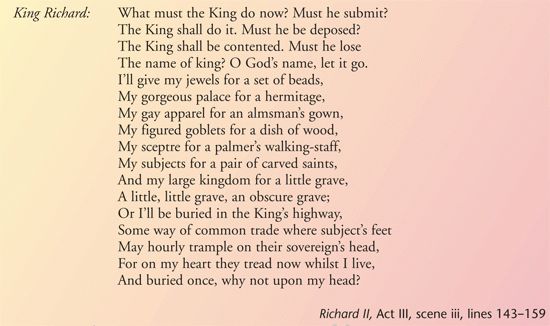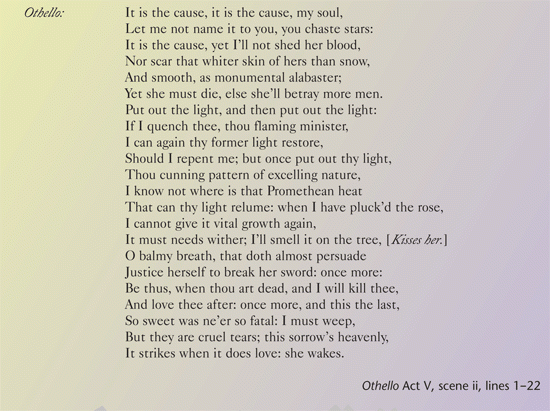Poetry and Prose
After studying this section you should be able to understand:
- how Shakespeare uses poetry and prose
- what imagery adds to the play
This video helps explain Shakespeare’s use of poetry and prose.
Poetry and Prose
Shakespeare’s plays are written mainly in poetry (verse) but he does use some prose too (ordinary writing not organised with rhymes or fixed line lengths).
The kind of verse form that Shakespeare uses is called ‘blank verse’. This kind of verse is the form of verse that is closest in rhythm to natural speech. This makes it the ideal form to use for dialogue. Blank verse is verse that does not rhyme and which is composed of lines called ‘iambic pentameters’.
An iamb is an unstressed syllable followed by a stressed syllable. Five iambs in a row make a line of iambic pentameter (‘pent’ means five in Greek, as in ‘pentagon’ or ‘pentathlon’). This means that each line has 10 syllables, five stressed and five unstressed, as in this line from Romeo and Juliet:
“But soft, what light through yonder window breaks?”
However, where necessary for his effects, Shakespeare may shorten lines or make them longer in order to express his meaning, or use enjambment (running on) where one line flows on into the next.
This speech from Richard II, where Richard resigns himself to giving up his crown, is written in regular iambic pentameter:

Shakespeare uses iambic pentameter quite differently in this speech, where Othello, believing Desdemona to have been unfaithful, prepares to kill her.

The speech from Richard II is much more regular and most of the lines are endstopped. The regularity of the rhythm pattern gives a solemn, ritualistic feel to the lines as Richard prepares to give up his crown.
Othello’s speech, although using elevated and emotional language, follows more closely the rhythm of speech.
Shakespeare sometimes divides a line into two by a pause (a caesura) and many of the lines run on (enjambment) and,where necessary, his lines contain more than the 10 syllables.
A central and noble character such as Hamlet also speaks in prose on occasion. Here, for example, he talks about the effect that his melancholy has on him and how he has lost all interest in the earth and mankind.
Even though written in prose, it does have poetic qualities to it. The language is elevated and uses imagery to explore the extent of his disillusionment.

